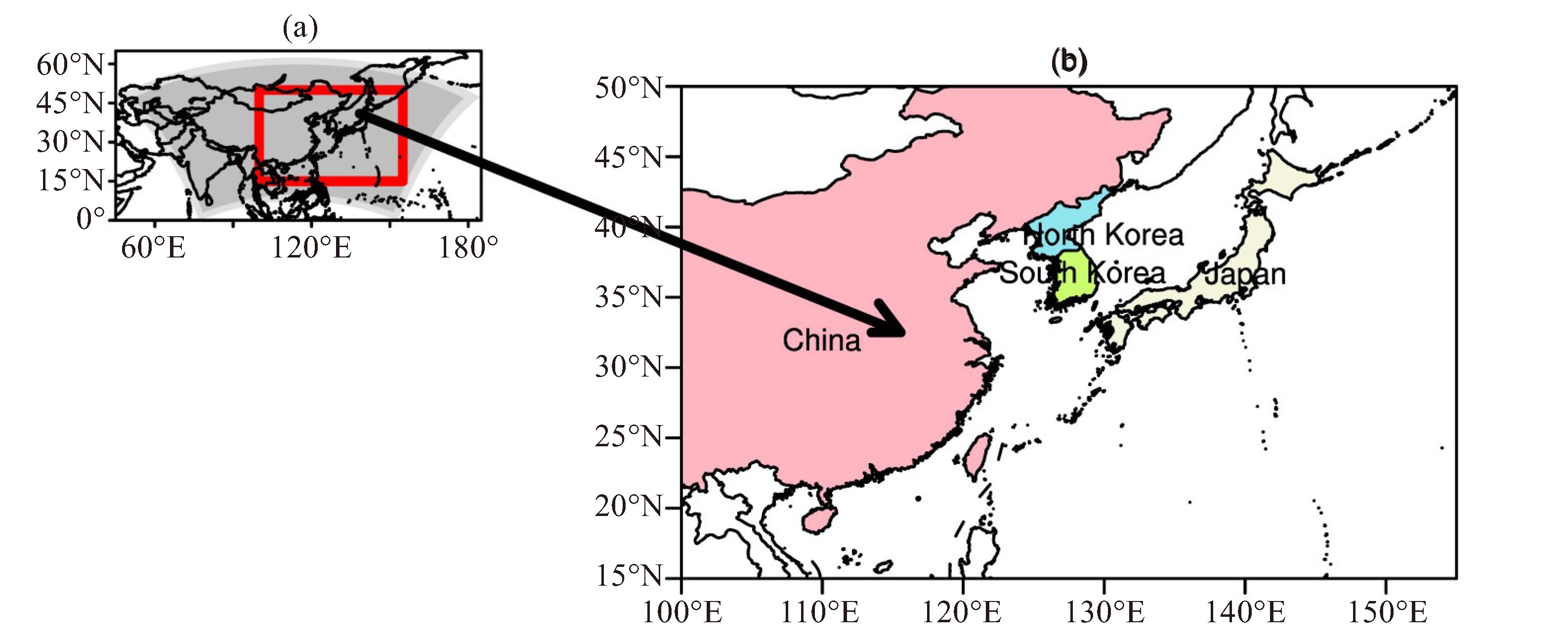Changes in Tropical Cyclone Activity Affecting East Asia over the Western North Pacific under Four Global Warming Targets of 1.5-4 ℃
-
摘要: 生成于西北太平洋的热带气旋(TC)每年严重影响我国及东亚各国沿海地区,合理预估不同全球温升水平下影响东亚的西北太平洋TC活动变化,可为东亚各国沿海地区有效适应气候变化和防灾减灾提供科学参考。本文基于4个CMIP5全球气候模式(EC-EARTH、HadGEM2-ES、MPI-ESM-MR和NorESM1-M)驱动RegCM4区域气候模式得到的高分辨率气候变化模拟集合结果(水平分辨率为25 km),预估了1.5 ℃、2 ℃、3 ℃和4 ℃全球温升水平下,影响东亚的西北太平洋TC活动在中和高(RCP4.5和RCP8.5)排放情景下的变化。结果表明,随着全球温升水平的提高,TC生成频率增加的范围逐渐扩大;TC路径频率增加的范围也逐渐扩展,且呈向极和向东方向偏移的趋势。与当代相比,未来4个全球温升水平下4月和6—9月的月平均TC数量都将增多,其中3 ℃ (4 ℃)温升水平下分别在6月、8月和9月(4月和7月)TC数量增加最多,增加值分别为0.79、0.92和1.25 (0.44和1.35)。从持续时间、TC等级和最小海平面气压三个描述TC强度特征的要素来看,在当代和未来不同全球温升水平下三个要素分布均相同,且较强的TC强度等级(等级为台风或强台风/最小海平面气压 < 980 hPa)中,最高温升水平(4 ℃)下TC数量较多,数值在1.48以上。相比当代,在3 ℃ (2 ℃)温升水平下登陆中国(日本)的TC数量增加最多,增加值为0.98 (0.75),登陆韩国和朝鲜的TC数量变化不大。Abstract: Tropical cyclones (TCs) generated in the western North Pacific (WNP) pose significant threats to China's coastal regions each year. Thus, projecting changes in TC activity over the WNP under different global warming scenarios holds substantial importance. Utilizing four CMIP5 global climate models (ECEARTH, HadGEM2-ES, MPI-ESM-MR, NorESM1-M) drive to the regional climate model RegCM4, simulations of East Asian climate change were performed. Projections of TC activity changes over the WNP under global warming targets of 1.5 ℃, 2 ℃, 3 ℃, and 4 ℃ were carried out. Results demonstrate that with increasing global mean temperature, the spatial distribution of areas with heightened TC genesis and occurrence frequency progressively enlarges. TC tracks tend to move poleward and eastward. Relative to the 1986-2005 baseline, under all four global warming scenarios, the monthly mean TC number in April and June-September is projected to rise. The largest increases in TC frequency are expected in June, August, and September (April and July) under the 3 ℃ (4 ℃) warming target, with increments of 0.79, 0.92, and 1.25 (0.44 and 1.35), respectively. In terms of duration, TC intensity, and minimum sea level pressure, their spatial distributions exhibit similarity across the present day and the four global warming scenarios. Projections indicate that under the 4 ℃ global warming target, the maximum number of strong TCs (typhoons and intense typhoons, defined by minimum sea level pressure < 980 hPa) will surpass 1.48. Projections suggest that the most substantial increases in TC landfall frequency over China (Japan) will be 0.98 (0.75) under the 3 ℃ (2 ℃) global warming target. Meanwhile, landfall frequencies over South Korea and North Korea are anticipated to remain relatively stable.
-
Key words:
- RegCM4 /
- global warming target /
- tropical cyclone /
- Western North Pacific /
- projection
-
图 5 同图 3,但为路径频率分布
表 1 当代和1.5~4 ℃全球温升水平下西北太平洋生成的年平均热带气旋数量(单位:个·a-1)
当代 1.5 ℃ 2 ℃ 3 ℃ 4 ℃ 23.5 25.0 26.0 27.8 29.0 -
[1] IPCC, Climate Change 2022: Impacts, adaptation and vulnerability. Contribution of Working Group Ⅱ to the Sixth Assessment Report of the Intergovernmental Panel on Climate Change[M]. New York: Cambridge University Press, 2022. [2] IPCC, Climate Change 2021: The Physical science basis, the Working Group Ⅰ contribution to the Sixth Assessment Report[M]. New York: Cambridge University Press, 2021. [3] ZENG N, DING Y, PAN J, et al. Climate change--the Chinese challenge[J]. Science, 2008, 319(5864): 730-731. [4] ZHANG Q, LIU Q, WU L. Tropical cyclone damages in China 1983—2006[J]. Bull Amer Meteorol Soc, 2009, 90(4): 489-495. [5] 聂心宇, 谭红建, 蔡榕硕, 等. 利用区域气候模式预估未来登陆中国热带气旋活动[J]. 气候变化研究进展, 2023, 19(1): 23-37. [6] GAO X J, GIORGI F. Use of the RegCM system over East Asia: Review and perspectives[J]. Engineering, 2017, 3(5): 766-772. [7] JIN C S, CHA D H, LEE D K, et al. Evaluation of climatological tropical cyclone activity over the western North Pacific in the CORDEXEast Asia multi-RCM simulations[J]. Climate Dyn, 2016, 47(3): 765-778. [8] AU-YEUNG A Y M, CHAN J C L. Potential use of a regional climate model in seasonal tropical cyclone activity predictions in the western North Pacific[J]. Climate Dyn, 2012, 39(3-4): 783-794. [9] WU L, CHOU C, CHEN C-T, et al. Simulations of the present and late-twenty-first-century western North Pacific tropical cyclone activity using a regional model[J]. J Climate, 2014, 27(9): 3 405-3 424. [10] WANG C, LIANG J, HODGES K I. Projections of tropical cyclones affecting Vietnam under climate change: downscaled HadGEM2-ES using PRECIS 2.1[J]. Quart J Roy Meteor Soc, 2017, 143(705): 1 844-1 859. [11] LEE H, JIN C S, CHA D H, et al. Future change in tropical cyclone activity over the western North Pacific in CORDEX-East Asia multiRCMs forced by HadGEM2-AO[J]. J Climate, 2019, 32(16): 5 053-5 067. [12] TORRES-ALAVEZ J A, GLAZER R, GIORGI F, et al. Future projections in tropical cyclone activity over multiple CORDEX domains from RegCM4 CORDEX-CORE simulations[J]. Climate Dyn, 2021, 57(5-6): 1 507-1 531. [13] WU J, GAO X J, ZHU Y, et al. Projection of the future changes in tropical cyclone activity affecting East Asia over the western North Pacific based on multi-RegCM4 simulations[J]. Adv Atmos Sci, 2022, 39(2): 284-303. [14] CHIH C H, WU C C, HUANG Y H, et al. Intense tropical cyclones in the western North Pacific under global warming: a dynamical downscaling approach [J]. J Geophys Res: Atmos, 2024, 129(1): e2023JD038598. [15] KNUTSON T, CAMARGO S J, CHAN J C L, et al. Tropical cyclones and climate change assessment: part Ⅱ: projected response to anthropogenic warming [J]. Bull Amer Meteorol Soc, 2020, 101(3): E303-E322. [16] TANG Y, HUANGFU J, HUANG R, et al. Simulation and projection of tropical cyclone activities over the western North Pacific by CMIP6 HighResMIP [J]. J Climate, 2022, 35(23): 4 171-4 194. [17] STUDHOLME J, FEDOROV A V, GULEV S K, et al. Poleward expansion of tropical cyclone latitudes in warming climates [J]. Nat Geosci, 2022, 15(1): 14-28. [18] GIORGI F, COPPOLA E, SOLMON F, et al. RegCM4: model description and preliminary tests over multiple CORDEX domains[J]. Clim Res, 2012, 52: 7-29. [19] GAO X J, SHI Y, GIORGI F. Comparison of convective parameterizations in RegCM4 experiments over China with CLM as the land surface model[J]. Atmos Oceanic Sci Lett, 2016, 9(4): 246-254. [20] GAO X J, SHI Y, HAN Z Y, et al. Performance of RegCM4 over major river basins in China[J]. Adv Atmos Sci, 2017, 34(4): 441-455. [21] 韩振宇, 高学杰, 石英, 等. 中国高精度土地覆盖数据在RegCM4/CLM模式中的引入及其对区域气候模拟影响的分析[J]. 冰川冻土, 2015, 37(4): 857-866. [22] 刘永强, 买买提艾力·买买提依明, 霍文, 等. 塔克拉玛干沙漠地表发射率及分布变化特征[J]. 沙漠与绿洲气象, 2014, 8(3): 1-7. [23] GAO X J, WU J, SHI Y, et al. Future changes in thermal comfort conditions over China based on multi-RegCM4 simulations[J]. Atmos Oceanic Sci Lett, 2018, 11(4): 291-299. [24] 吴婕, 高学杰, 徐影. RegCM4模式对雄安及周边区域气候变化的集合预估[J]. 大气科学, 2018, 42(3): 696-705. [25] WU J, GAO X J. Present day bias and future change signal of temperature over China in a series of multi-GCM driven RCM simulations[J]. Climate Dyn, 2020, 54(1): 1 113-1 130. [26] 张冬峰, 高学杰. 中国21世纪气候变化的RegCM4多模拟集合预估[J]. 科学通报, 2020, 65(23): 2 516-2 526. [27] 吴婕, 韩振宇, 石英, 等. 中国及其屏障区柯本气候分类的RegCM4集合预估[J]. 科学通报, 2022, 67(1): 99-112. [28] SHI Y, WANG G, GAO X J. Role of resolution in regional climate change projections over China[J]. Climate Dyn, 2018, 51(5-6): 2 375-2 396. [29] JIANG D B, TIAN Z P, LANG X M. Reliability of climate models for China through the IPCC Third to Fifth Assessment Reports[J]. Int J Climatol, 2016, 36(3): 1 114-1 133. [30] HAZELEGER W, SEVERIJINS C, SEMMLER T, et al. EC-Earth A seamless Earth-System prediction approach in action[J]. Bull Amer Meteorol Soc, 2010, 91(10): 1 357-1 363. [31] COLLINS W J, BELLOUIN N, DOUTRIAUX-BOUCHER M, et al. Development and evaluation of an Earth-System model-HadGEM2[J]. Geosci Model Dev, 2011, 4(4): 1 051-1 075. [32] JUNGCLAUS J H, FISCHER N, HAAK H, et al. Characteristics of the ocean simulations in the Max Planck Institute Ocean Model (MPIOM) the ocean component of the MPI‐Earth system model[J]. J Adv Model Earth Syst, 2013, 5(2): 422-446. [33] STEVENS B, GIORGETTA M, ESCH M, et al. Atmospheric component of the MPI‐M Earth System Model: ECHAM6[J]. J Adv Model Earth Syst, 2013, 5(2): 146-172. [34] BENTSEN M, BETHKE I, DEBERNARD J B, et al. The Norwegian Earth System Model, NorESM1-M-Part 1: Description and basic evaluation of the physical climate[J]. Geosci Model Dev, 2013, 6(3): 687-720. [35] IVERSEN T, BENTSEN M, BETHKE I, et al. The Norwegian Earth System Model, NorESM1-M-Part 2: Climate response and scenario projections [J]. Geosci Model Dev, 2013, 6(2): 389-415. [36] CAO X, WATANABE M, WU R, et al. The projected poleward shift of tropical cyclogenesis at a global scale under climate change in MRI‐ AGCM3.2H [J]. Geophys Res Lett, 2024, 51(3): e2023GL107189. [37] KREUSSLER P, CARON L P, WILD S, et al. Tropical cyclone integrated kinetic energy in an ensemble of HighResMIP simulations [J]. Geophys Res Lett, 2021, 48(5): e2020GL090963. [38] MOON Y, KIM D, WING A A, et al. An evaluation of tropical cyclone rainfall structures in the HighResMIP simulations against satellite observations [J]. J Climate, 2022, 35(22): 3 715-3 738. [39] ROBERTS M J, CAMP J, SEDDON J, et al. Impact of model resolution on tropical cyclone simulation using the HighResMIPPRIMAVERA multimodel ensemble [J]. J Climate, 2020, 33(7): 2 557-2 583. [40] ZHANG W, VILLARINI G, SCOCCIMARRO E, et al. Tropical cyclone precipitation in the HighResMIP atmosphere-only experiments of the PRIMAVERA Project [J]. Climate Dyn, 2021, 57(1-2): 253-273. -






 下载:
下载:








 粤公网安备 4401069904700003号
粤公网安备 4401069904700003号